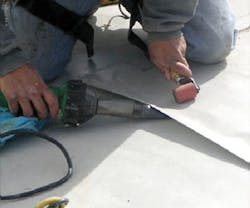Thermoplastic polyolefin (TPO) membranes are desirable due to their durability and hot-air weldable seams. And while they are highly resistant to tears, impacts, and punctures, they are not immune to these building-damaging flaws.
An improper quick fix after discovering one of these flaws is not the solution – it may be inexpensive now, but will be more expensive tomorrow when you need to fix more than just the initial problem.
Patching Problems
Because TPOs are heat weldable, you can make a patch if there is a simple puncture. But in order to make this patch, you'll need electricity, a hot-air welding tool, and patching material – tools that professional roofing contractors will have on hand, but an average building owner probably won't.
This leaves you in a potentially tricky (or sticky) situation. "Where is the average building owner going to find that 1 square foot of patching material?" says Richard Fricklas, former technical director at the now-defunct Roofing Industry Educational Institute (RIEI), coauthor of the fourth edition of the Manual of Low Slope Roofing, and author of the BUILDINGS monthly roofing newsletter, Roofing News.
And what if your roof membrane is no longer commercially available? "If we had the insight, we could have prevailed upon the roofer to leave us some extra material when he put the roof down," Fricklas adds. "Perhaps the best thing to do would be to put some duct tape on the puncture and call the roofer."
Another alternative would be to make a patch with asphalt mastic, which is available at most lumber yards. While this sounds like a simple and straightforward approach, it may create more work in the long run. "It would keep the water out until proper materials can be located, but the entire smeared area now needs to be cut out and a larger repair made, single-ply to single-ply," Fricklas says.
Proper Preparation
Chances are, even your best repair efforts will be useless unless the surface is properly cleaned first. "Probably the most common mistake when attempting repairs on any roof is not preparing the surface of the existing membrane to accept the repair," says Bob McNeill, Carlisle Syntec's director of technical and warranty services.
"TPO systems must be cleaned to ensure the surface is free from dirt and contaminants. The key to successful TPO repair is ensuring no residual dirt or contaminants are present prior to making the repair."
Most manufacturers supply specialized cleaners to clean the repair area, but it may not be easy for a building owner to get his or her hands on them, and preparing the area for repaires may require several steps.
"There may be a special cleaner-primer, a detergent wash, and a rinse, or even mild abrasion," Fricklas explains. "Most systems need a primer, about 5 drops of liquid. Where do we get that? Probably at a roofing wholesaler, and the smallest container might be a 5-gallon pail.Not only that, the solvent may be red label and have an objectionable odor that may be drawn into the building by the HVAC."
And if your roof is older and has been exposed to the elements (and what roofs haven't been?), preparation is no simple task. "If the existing membrane is exposed for an extended period of time, surface oxidation can occur and a more aggressive cleaning could be required," McNeill says.
Coverage Contract
A roofing repair may not just ruin your day – it can ruin your roof's warranty. "If the building owner/occupant or an 'unapproved' roofing contractor does the repairs, the warranty may be voided," Fricklas cautions. "It is essential that the owner notify the warrantor as soon as possible and get permission to include the repairs under the scope of the warranty."
While you should investigate to understand the roofing system, perhaps the best way to prevent roofing repair mistakes is to limit yourself to temporary repairs and not attempt to make a permanent repair yourself, according to McNeill.
"The best way for building owners and facility managers to avoid mistakes is to hire professional contractors to make any needed repairs to their roofing systems."
Kylie Wroblaski is associate editor of BUILDINGS.
